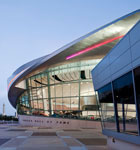Project
Location Charlotte, NC
Size 150,000 ft2
Completed 2010
Program Exhibit space, entry plaza, lobby, theaters
Awards 2011 Award of Merit, Illuminating Engineering Society
A single lux—a basic building block of lighting—is an apt identifier for a business that works with light the way an author works with words. One Lux Studio has used lights to tell the stories of Class A office buildings, luxury hotels, and upscale restaurants. But at the NASCAR Hall of Fame in Charlotte, North Carolina, One Lux Studio has employed light to express the color, excitement, motion, and spectacle of racing. Jack Bailey, a partner at the New York-based studio, explains how his firm approached the project.
How did you become a part of this project? Are you a NASCAR fan?
Jack Bailey: We’ve done a lot of work with Pei Cobb Freed & Partners over the years, and they contacted us after they won the project in a design competition. Like most of the project team, I didn’t know much about NASCAR. But the folks at the Hall of Fame took us to a race, and I found that NASCAR is a lot more interesting than I thought. There are the personalities involved and the competition between the drivers but also the technology of the cars and the visceral sense of danger. There’s a real excitement there, and that got me excited about the project.

The lights on building's Ribbon, its stainless-steel mobius strip, race around it, evoking cars on a racetrack.
What was your design objective?
Bailey: With most of our projects the goal is to reinforce and complement the architect’s vision. In this case, there’s a story behind the architecture. The Ribbon, a stainless-steel mobius strip that wraps around the building, is representative of a racetrack. The lights on The Ribbon start moving slowly in formation like the cars on a racetrack under a yellow flag and then pick up speed and become more random as they whip around “the track” counter-clockwise. The ramp inside the Great Hall starts out very flat and gets steeper as it wraps up to the second floor exhibit space, replicating the slope of the turns at different race tracks.
Team
Lighting Designer One Lux Studio
Owner City of Charlotte
Color Change System Philips Color Kinetics
Light Fixtures 3G, Mark Lighting, Starfire, Kurt Versen
Architect Pei Cobb Freed & Partners
Exhibit Design Ralph Appelbaum Associates
Structural Engineer Leslie E. Robertson Associates
MEP Engineer Jaros Baum & Bolles
What was the greatest lighting challenge?
Bailey: Understanding the geometry of the building and finding mounting positions for lighting. For example, ceiling heights in the Great Hall vary from 60 feet to 15 feet, and many of the architectural elements are curved or twisting. Finding accessible locations that worked for the lighting was very difficult. We chose dimmed halogens for all recessed lighting to provide flexibility for evening events.
What was the biggest construction challenge?
Bailey: The Ribbon lighting. We did full-scale mock-ups of a section of the pocket that holds the lights, but the reality is that this looks much different in our conference room than on the side of a building 80 feet above the street. It took several on-site mockups to get the lighting and materials just right.
Did you use special light fixtures or equipment?
Bailey: The color-changing light system on The Ribbon was provided by [Philips] Color Kinetics. This required a lot of planning and programming time, and Color Kinetics was very supportive. At this size, the installation becomes a data-management challenge because there are so many different control channels. We needed a distributed IT network throughout the building just for this system. 3G, Mark Lighting, Starfire, and Kurt Versen also provided customized light fixtures for the project.

A type of Viracon glass with special UV coating was selected for the Hall of Fame facade, to protect the race cars on displays.
Green
CERTIFICATION LEED Silver
Lamps Ceramic metal halide sources and compact fluorescents conserve energy
Daylighting Viracon glass with UV coating allows daylight without negatively affecting the historical racecars
Were there concerns about protecting the older cars from light damage?
Bailey: Yes, the older racecars did not have UV-stabilized paint because they weren’t expected to last more than a few races. While the halogen lights in the Great Hall create little UV exposure, daylighting through the north-facing glass wall of the building was a major concern. However, a Viracon glass with special UV coating was selected, and this glass was well shaded by The Ribbon. Our extensive analysis showed that cars sitting inside the Great Hall receive as much UV exposure in one year as cars sitting outside receive in two days, and this satisfied the preservation concerns.
What role did energy efficiency and conservation play in the lighting design for this facility?
Bailey: Ten years ago, a museum like this would have been lighted entirely with halogen lamps. But the color rendition of ceramic metal halide sources has gotten so good that we were able to use these for much of the lighting in high-ceiling spaces. Dimmed fluorescent and compact fluorescent were used in many of the low-ceiling spaces. Overall, a lot of energy was saved.

